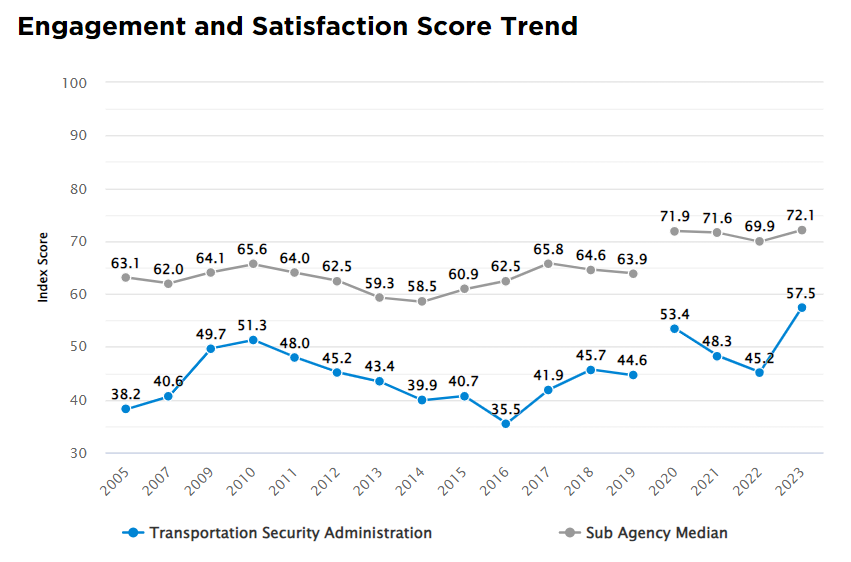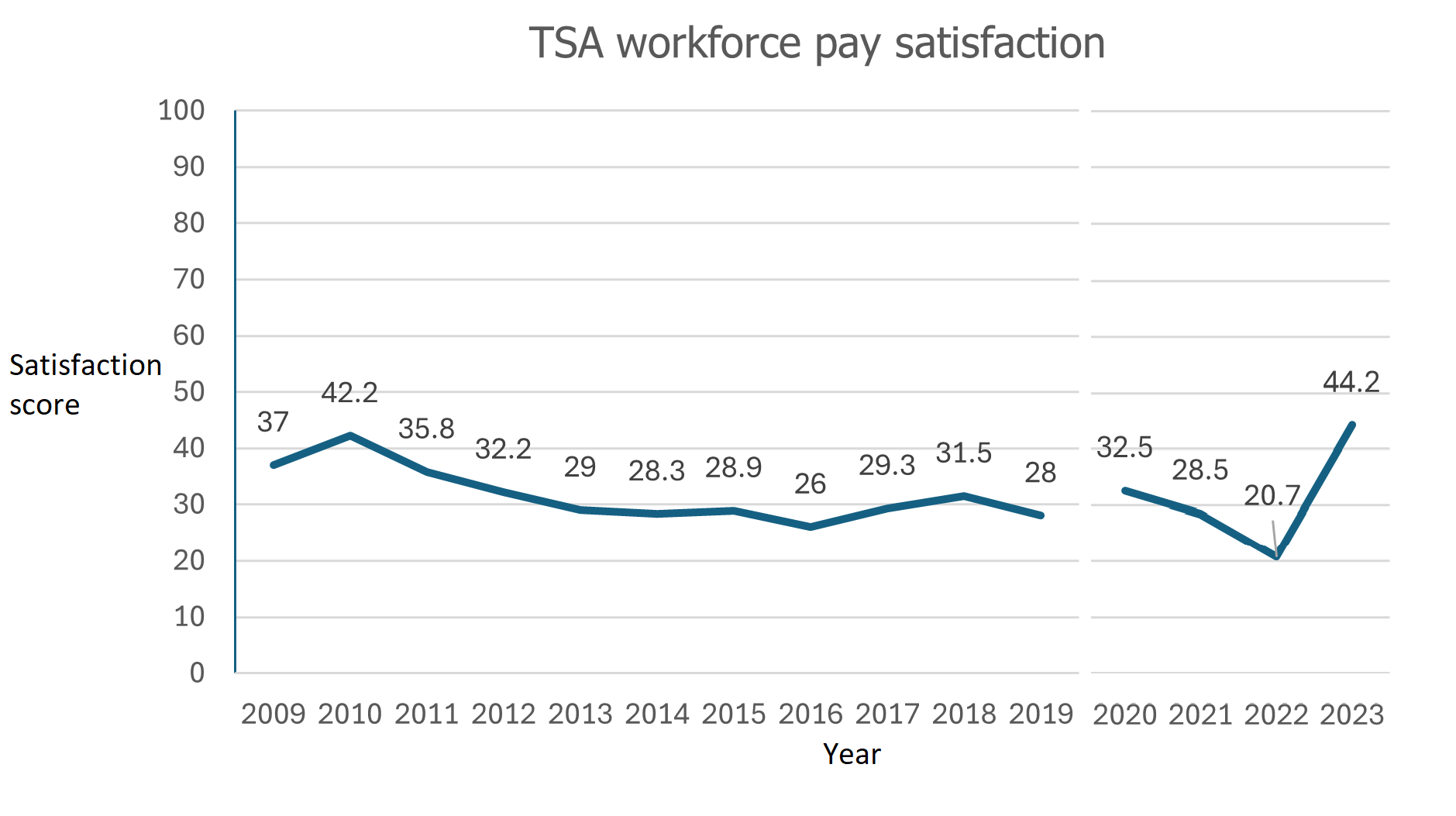TSA looking beyond ‘honeymoon phase’ for frontline workforce
After the recent pay increase, TSA is trying to further improve staff retention by creating career ladders and better defining steps for promotions.
Editor’s Note: This story is part of a DHS special report for Federal News Network. Check back for more interviews and content about DHS’ workforce engagement and satisfaction efforts throughout the week.
A recent pay increase at the Transportation Security Administration has cut the agency’s attrition rate in half. But beyond staving off attrition, TSA leaders are also looking to build retention and solve some of the agency’s historic workforce challenges.
Employee engagement and satisfaction at TSA, a component of the Department of Homeland Security, improved by a significant margin in just the last year. Between 2022 and 2023, TSA increased its overall score by 12.3 points in the results of the Partnership for Public Service’s Best Places to Work in the Federal Government rankings. Moving from a score of 45.2 to 57.5 out of 100 is the highest year-over-year increase TSA has had since the Partnership’s rankings began 2005.
Jason Nelson, chief human capital officer at TSA, credited the improvements in large part to the pay increase TSA employees first received in 2023.
“We were really starting to compete with fast food places, warehouses or big box stores, when really, this is more of a career,” Nelson said in an interview with Federal News Network. “A lot of our staff would walk across the hall go to another agency, because we couldn’t pay as well.”

Of TSA’s 60,000 employees, roughly 42,000 are transportation security officers (TSOs) working at nearly 440 airports nationwide and screening more than 2 million passengers daily. The other about 25% of TSA employees work in back-office functions. With the pay raise that began last year, some TSOs saw as much as a 31% pay boost.
“It’s life-changing,” Nelson said. “People are saying they got the surgery they’ve been putting off, or they moved out of their parents’ house for the first time … It’s just so amazing to get out there and see the faces of the people and the tears of joy. When you see these things on paper, it’s very different.”
The effects of the pay increases shone through in the Partnership’s Best Places to Work results as well. Pay satisfaction scores for TSA employees have more than doubled since 2022.

Before the pay boost, the TSA workforce was paid noticeably lower than many federal employees at comparable levels on the General Schedule (GS). The disparity led to high staff attrition rates at TSA.
But since the raise took effect, and was continued through 2024, TSA has reported more interest in job openings, as well as a 9% drop in staff attrition rates, decreasing from 20% to now roughly 11%. In other words, TSA retained about 88% of its frontline employees — the highest annual retention rate in the agency’s history. TSA also hired over 9,000 new TSOs and security support assistants during 2023, the agency said.
“It’s unbelievable. I mean, to go down and cut your losses by half is really something else,” Nelson said. “Everyone is excited — I’m excited. But as a human capital officer, I also have to be realistic.”
Creating career ladders for TSOs
Nelson described the drop in staff attrition as a “honeymoon phase” — and he’s already wary of how long the high retention rates can be maintained without digging into further workforce challenges at the agency. Compared against other agency subcomponents across government, TSA is still in the bottom quartile of the Partnership’s rankings.
As one way to try to further improve staff retention, TSA is creating “career ladders,” or more defined steps for getting promoted and moving up in the agency. Nelson said he had regularly heard concerns about the lack of career development opportunities from employees who filled out the Federal Employee Viewpoint Survey (FEVS) or took other opportunities to offer feedback.
“We’ve heard from the staff very, very clearly that in order to make it a career, it’s about more than just base pay. It’s about advancement,” Nelson said. “It took many, many years of planning, and of course budgeting, but it all came from the feedback from our employees.”

TSA now uses a “pay band” system, which in practice means new TSA employees can come in as a GS-5 equivalent, but can then move up to a GS-7, and eventually a GS-9, within their first three years on the job. The new career ladder system, now about one year in, lets employees move up those steps based on their own performance, rather than having to compete with their colleagues for higher positions.
Nelson said the better predictability of TSO salaries over the first couple of years at the agency, as well as being able to see the pay band system that’s now in place, should lead to better staff retention.
“Now people are saying, ‘I might make a little bit less than another job I’m being offered, but in two years, I’ll be up 50% or 60%. I’m not going to get that with competitors outside of the government,’” Nelson said. “Especially because we hire people in high school, people coming out of the military [and] a lot of people coming out of restaurants and the fast food industry looking for a career, it’s really exciting to show that stability in their life.”
Moving forward, Nelson said he’s also trying to figure out how to incorporate career development and advancement opportunities by creating formalized career paths in TSA, clearer ways for TSOs to get promoted to leads, and then supervisors — and possibly offering career paths for TSA employees to convert to positions elsewhere in DHS.
“We want our leaders to be critical thinkers. We want them to have empathy. We want them to be problem solvers,” Nelson said. “We want to make sure that the people that move up have some of those skills or the potential to learn them, as opposed to just being around the longest.”
Expanded collective bargaining for TSA staff
Many of TSA’s recent workforce improvements have also come as a result of a new collective bargaining agreement (CBA) with the American Federation of Government Employees. The contract, signed in May, is TSA’s first-ever full-fledged CBA. The agreement expands collective bargaining rights through a streamlined grievance process, increased official time, eased restrictions on sick leave, opportunities for local collective bargaining — and much more.
“It’s only going to help morale, especially when management and the union are so in lockstep with the issues and with the things that we want to do, and the successes that we made,” Nelson said.
Even seemingly small changes can make a big difference for employees. Polo shirts, as an example, are now allowed as part of TSOs’ uniform options. Under the new CBA, employees working in warmer climates can wear polo shirts throughout the year to try to get relief on especially hot days.
“That was such a big deal for so many people because that’s their life every day, 40 hours a week or more,” Nelson said. “You’d think that’s not something that would be on a lot of people’s minds, but it was on the employees’ minds.”

Nelson said he also travels to various locations across the country to talk to TSOs in person and try to make the message clear that the agency is listening and trying to make changes based on their direct feedback.
“A lot of times, our frontline workforce [are] on their feet, they’re in the airports, they’re inspecting surface areas, they’re moving around the country, or they’re law enforcement, flying an aircraft or driving vehicles,” Nelson said. “It’s rare that they can get on email, so we try to do this stuff more in person.
What’s next for TSA’s workforce
Beyond the pay increases and new career ladders, Nelson said TSA’s requirement of creating location-specific action plans based on FEVS results will help make even more improvements for the workforce down the line.
Although there is some overlap in what issues TSOs are facing across the country, Nelson said it’s also dependent on the airport and the city where employees are working.
“We do have some locations where you would see some equity and inclusion issues, and other places that we would see work-life balance issues,” Nelson said. “We look at the grand scale, of course, but those action plans by location are critical.”
For instance, Nelson said one crucial issue among more remote locations across the country — like Nome, Alaska; Jackson Hole, Wyoming; Key West, Florida; or the Northwestern Islands of Hawaii — is the availability of housing near airports.
“There’s no place to live,” Nelson said. “Even if we pay people double, they just can’t get the housing.”
After receiving the action plans and visiting some of the more remote locations to speak with TSOs in those areas, Nelson said he’s now working with DHS and the Defense Department to try to offer alternative and more affordable housing options for staff.
And in conversations with TSOs, Nelson said he now uses the example of the recent pay increase to show how much of a difference employee input can make.
“We remind our staff that it’s because they talked about it, it’s because they raised it,” Nelson said. “It came up in the survey year over year, and we used those results on the congressional floor and in testimony to show how critical it is for our retention.”
Copyright © 2024 Federal News Network. All rights reserved. This website is not intended for users located within the European Economic Area.
Drew Friedman is a workforce, pay and benefits reporter for Federal News Network.
Follow @dfriedmanWFED






